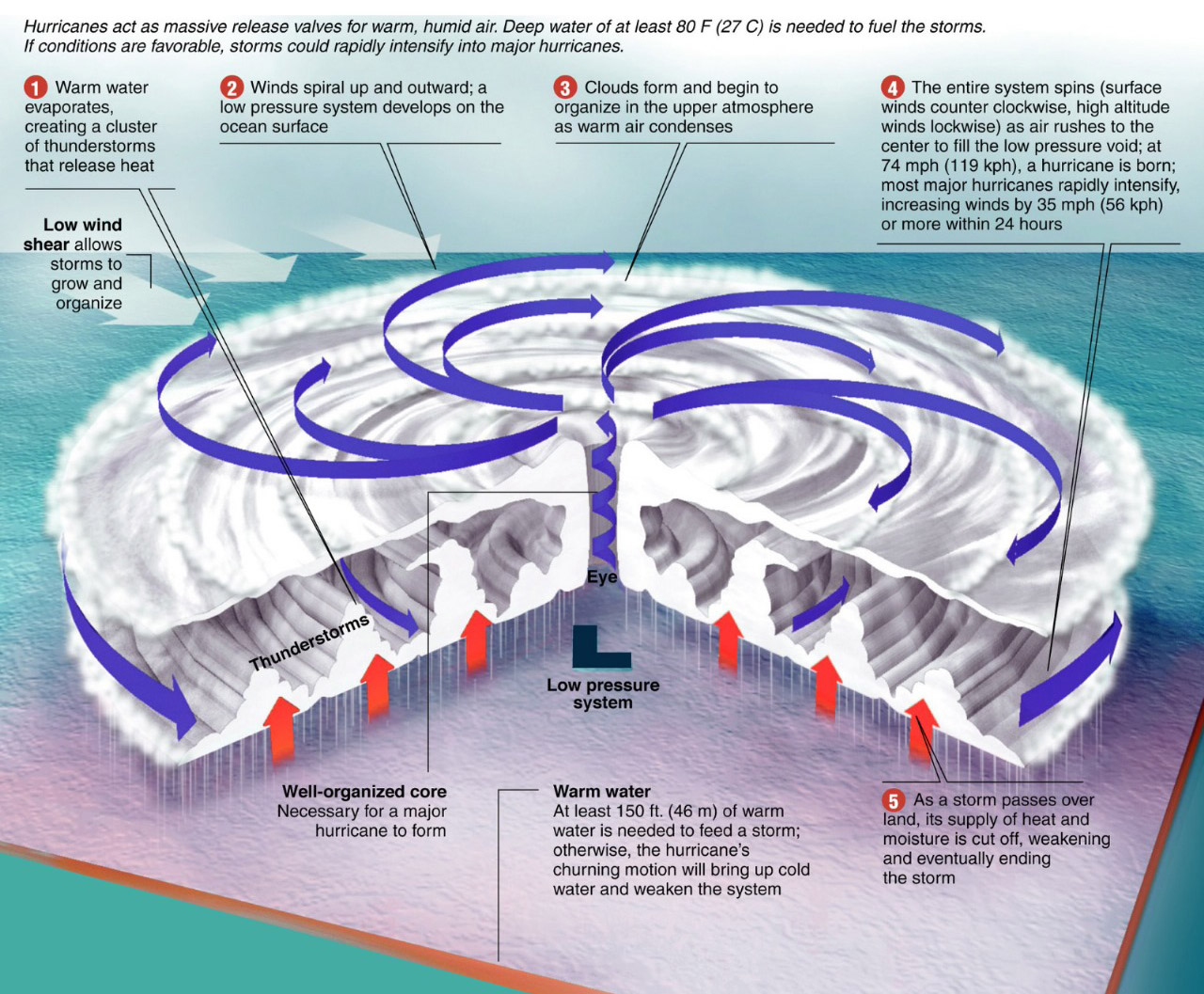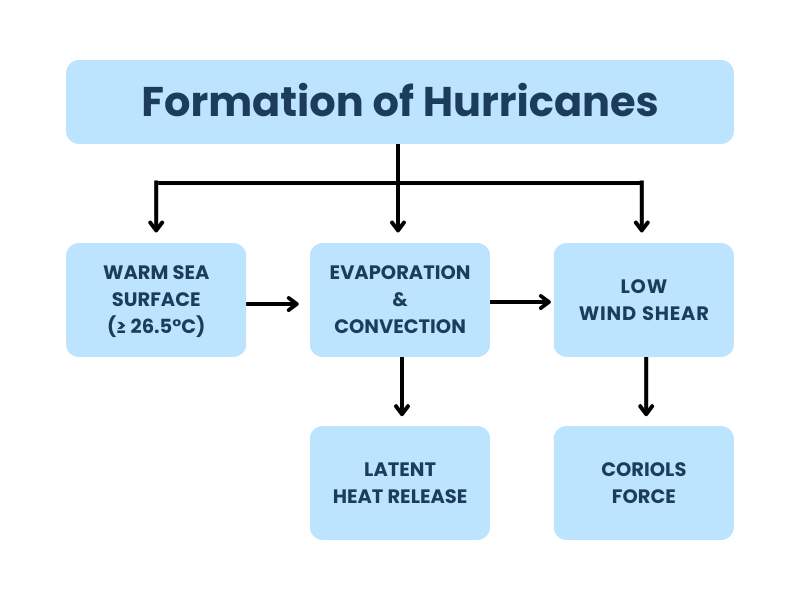
Hurricanes are among the most destructive natural disasters, causing extensive human, economic, and environmental losses. This study provides a comprehensive analysis of hurricane behavior, classification systems, forecasting technologies, and the escalating impacts of these storms in a warming climate. Using a comparative qualitative methodology, it examines regional differences in cyclone categorization, the evolution of satellite and radar monitoring, and the integration of artificial intelligence (AI) in damage assessment and early warning systems. Historical and recent case studies—including Hurricanes Katrina, Harvey, Maria, and Dorian—highlight disparities in emergency response, infrastructure resilience, and community recovery, especially in marginalized populations. The findings emphasize the importance of adaptive policies, equitable aid distribution, and inclusive planning to strengthen resilience. As climate change intensifies hurricane activity, this research underscores the urgent need for interdisciplinary approaches that integrate scientific innovation, local governance, and social equity in disaster preparedness and response.
Hurricanes, also known as cyclones or typhoons in other regions—are among the most destructive natural disasters on Earth. These intense tropical storms typically form over the Atlantic or eastern Pacific Ocean when sustained wind speeds exceed 74 miles per hour (119 km/h) (Clements & Casani, 2016; Trenberth, 2007). They develop as warm, moist air rises from the ocean surface, generating a low-pressure system that begins to rotate due to the Coriolis effect.
Notable hurricanes in recent U.S. history, such as Katrina (2005), Harvey (2017), and Irma (2017), have caused catastrophic human and economic losses. Hurricane Katrina resulted in over 1,800 fatalities and an estimated $108 billion in damages (Martinez, 2024). Harvey’s heavy rainfall led to widespread flooding in Texas, while historical hurricanes like the 1932 Cuba Hurricane and the 1900 Galveston Hurricane similarly caused thousands of deaths (Martinez, 2024), underscoring the long-standing vulnerability of coastal regions.
Recent studies indicate a significant increase in both the frequency and intensity of hurricanes, particularly in the North Atlantic. Over the past 150 years, observational data reveal that more hurricanes are intensifying rapidly, a trend strongly linked to rising sea surface temperatures driven by global warming and greenhouse gas emissions (Venegas et al., 2024). Between 2019 and 2023, warmer ocean waters contributed to increased wind speeds—up to 18 mph higher in nearly 80% of Atlantic hurricanes (Climate Central, 2024; National Science Foundation, 2022; Rowan University, 2023).
This upward trend in hurricane activity poses substantial challenges to disaster preparedness, forecasting, and climate resilience. Coastal communities, in particular, face disproportionate risks due to their exposure and often limited adaptive capacity. The increasing unpredictability in storm tracks and intensity complicates response planning. Without proactive mitigation and adaptation strategies, the burden of hurricanes is projected to escalate in the coming decades. As such, advancing our understanding of hurricane behavior is essential for enhancing early warning systems, strengthening community preparedness, and informing climate adaptation efforts. Researchers and policymakers are now prioritizing integrated, interdisciplinary approaches to reduce hurricane-related risks and promote long-term resilience.

A comprehensive understanding of hurricanes involves knowledge of their formation mechanisms, geographic distribution, and the remote sensing technologies used for detection and forecasting. It also includes an understanding of how hurricane intensity is measured and how modeling supports both emergency management and scientific analysis. Beyond the initial impact, hurricanes often result in prolonged social, economic, and environmental consequences, collectively referred to as the aftermath. Addressing these challenges requires mitigation strategies that reduce exposure and vulnerability—such as early warning systems, resilient infrastructure, and climate adaptation measures.
Over the past 150 years, changes in sea surface temperatures and atmospheric conditions have contributed to stronger and more frequent hurricanes in the North Atlantic (U.S. National Science Foundation, 2022). Recent studies show that from 2019 to 2023, about 84% of Atlantic hurricanes intensified by at least one category on the Saffir-Simpson Hurricane Wind Scale, largely due to climate change (Climate Central, 2024).
The primary driver of this trend is warmer ocean temperatures, which increases the energy available for storms. These higher temperatures can raise wind speeds by as much as 28 mph (Climate Central, 2024). The unusually active 2017 hurricane season, along with all eleven named storms in 2024, further illustrate this intensification pattern (Climate Central, 2024; Martinez, 2024).
These changes highlight the urgent need to adapt infrastructure and policy strategies based on lessons learned from past storm events.
Tropical cyclones have historically posed significant threats to human life, infrastructure, and economic systems. Several major hurricanes exemplify the severity of their impact.
Hurricane Katrina (2005) made landfall as a Category 3 storm, resulting in approximately 1,800 fatalities and $108 billion in damages, largely due to storm surge and levee failures in New Orleans (Martinez, 2024; Rohland, 2017). Hurricane Harvey (2017), the wettest tropical cyclone in U.S. history, brought over 50 inches of rain to Texas and caused an estimated $125 billion in damage (Bang et al., 2019; Federal Emergency Management Agency [FEMA], 2018; Xu et al., 2019). That same year, Hurricane Irma produced sustained winds of 185 mph for 37 consecutive hours, significantly reshaping Tigertail Beach in Florida by redistributing vast volumes of sand (Harvey et al., 2021).
Hurricane Maria (2017) was the most powerful storm to strike Puerto Rico in over eight decades, resulting in widespread infrastructure collapse and prolonged power outages. While recovery programs such as FEMA’s Individuals and Households Program (IHP) were implemented, delays and systemic inequities disproportionately impacted low-income and property-insecure populations (Lamba-Nieves & Santiago-Bartolomei, 2022; Mensah-Larkai et al., 2025; Sanders et al., 2022).
Historically, earlier hurricanes underscore the long-standing danger of storm surge and inadequate early warning systems. The 1900 Galveston Hurricane remains the deadliest natural disaster in U.S. history, with an estimated death toll between 8,000 and 12,000 (Martinez, 2024). The 1928 Okeechobee Hurricane caused over 2,500 fatalities in Florida when a lake surge overwhelmed local levees. The 1932 Cuba Hurricane, the deadliest late-season Atlantic cyclone, led to nearly 3,101 deaths.
More recently, Hurricanes Helene and Milton (2024) brought devastating impacts to Florida and the southeastern United States, causing at least 238 fatalities and extensive flooding (Martinez, 2024).
As illustrated in Figure 1, storm surge accounts for 50% of cyclone-related deaths, making it the primary cause of mortality in such events (Clements & Casani, 2016). Figure 2 shows how storm surge, when combined with normal high tide, results in a storm tide that can raise sea levels by up to 17 feet above the mean sea level. These conditions explain the catastrophic coastal flooding observed during hurricanes.
Despite the presence of emergency aid programs, recovery efforts often experience delays, especially in marginalized communities without clear property documentation. These examples reveal that tropical cyclones pose not only environmental risks but also social and institutional challenges. Thus, improving forecasting accuracy, strengthening infrastructure, and ensuring equitable recovery processes remain crucial priorities.
Hurricanes typically form between 5° and 25° latitude in tropical regions where specific atmospheric and oceanic conditions align. Warm sea surface temperatures (above 26.5°C), low vertical wind shear, mid-level humidity, and the Coriolis effect are all essential for development. These factors contribute to rising warm, moist air, which releases latent heat and strengthens the storm system. Additional drivers like surface heat flux and air-sea interactions further fuel intensity. Due to the complex interplay of these elements, forecasting hurricane formation remains a significant scientific challenge.

Hurricanes typically evolve through several stages (Hart, 2006; National Ocean Service, 2024). The process begins with unorganized disturbances such as easterly waves or mesoscale convective systems, which can develop into tropical depressions when sustained wind speeds are below 39 mph (Hart, 2006; National Ocean Service, 2024).
When wind speeds increase to between 39 and 73 mph, the system is classified as a tropical storm. If winds reach 74 mph (119 km/h) or more, the system becomes a hurricane (National Ocean Service, 2024).
During intensification, the release of latent heat helps maintain the hurricane’s warm-core structure (Yanai, 1964). The formation of the eye often signals the onset of rapid intensification (Vigh et al., 2012). Strong cumulus convection drives vertical transport of energy, enhancing the buoyancy gradient that fuels the storm (Smith, 2000).
However, unfavorable conditions such as low mid-level humidity, convective downdrafts, and dry air intrusion can weaken or suppress storm development (National Ocean Service, 2024). Landfall, increased wind shear, and interaction with dry air commonly lead to storm dissipation.
After a hurricane passes, it usually leaves behind a “cold wake” by cooling the ocean surface beneath it. These cooler waters may take between 5 to 20 days to return to their normal temperature (Price et al., 2008). Due to the complex interactions and rapid changes involved, predicting the exact timing and development of hurricane genesis remains a major scientific challenge (Yanai, 1964).


The study of hurricanes necessitates interdisciplinary collaboration, drawing on meteorology, geography, climate science, and public policy. Integrating insights from natural systems with societal responses is essential to improving disaster preparedness and response. Given the documented increase in the frequency and intensity of extreme weather events associated with climate change, enhancing community preparedness and resilience is critical—particularly for populations in vulnerable coastal and low-lying regions.
Despite the broad scope of the study, a number of limitations should be recognized. First, although the study summarizes findings from around the world, it places a significant emphasis on the Atlantic basin given greater availability of data and the preponderance of U.S.-based research. Second, the pace of progress in both AI and remote sensing creates a moving target. New advances and innovations in these fields may render some of the conclusions in this study irrelevant in a matter of months. Third, secondary data collection is subject to biases. There may be biases in aid distribution and social impact time series data. Fourth, climate models used to run hurricane scenarios vary in resolution and assumptions, leading to uncertainty in the long-term projections from these models. Fifth, real-time data from lower income or more vulnerable regions are scarce and limits the generalization of findings to all regions. Future research should address these limitations through primary field data collection, model validation, and comparison to other regions.
Hurricanes are a growing global threat because of higher sea surface temperatures, population growth, urbanization, and persistent inequalities. The development of hurricanes is still often mysterious and scientifically challenging; however, hurricanes intensification is more certain and increasingly anthropogenic climate change. We have made progress in understanding hurricanes using satellites, numerical modeling, AI-based forecasting, and post-disaster assessment, but there are still knowledge gaps in building long-term vulnerability, aid distribution, and mental health recovery.
Successful preparedness is more than a forecast. It is a multi-level, inclusive, and sometimes transformative response that prioritizes vulnerable populations, reforming governance, and integrating new technologies. The history of Hurricanes Katrina, Harvey, and Maria shows the dangers of delayed action and the opportunities for transformative learning.
When community planning, AI-prediction, and adaptive policy converge, we must ask: how can future responses be more anticipatory, coordinated, and recovery focused? In this regard, resilience cannot be an outcome, but instead must be an inclusive, continuous, and technology-enabled process of adaptation.